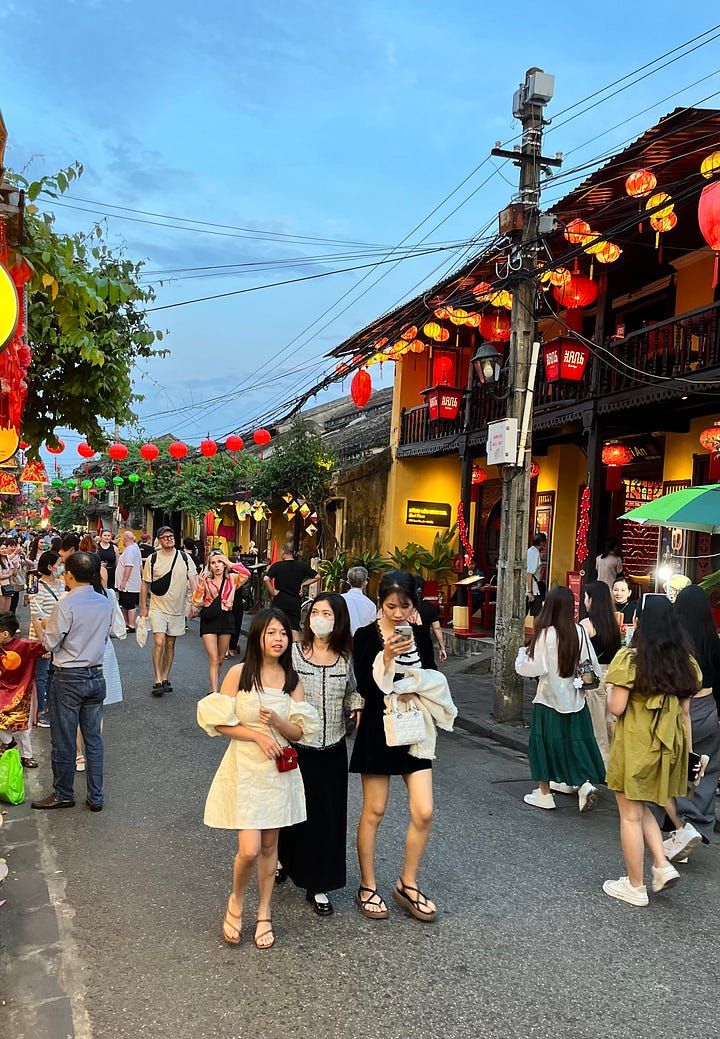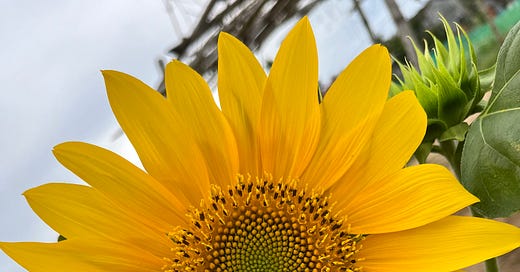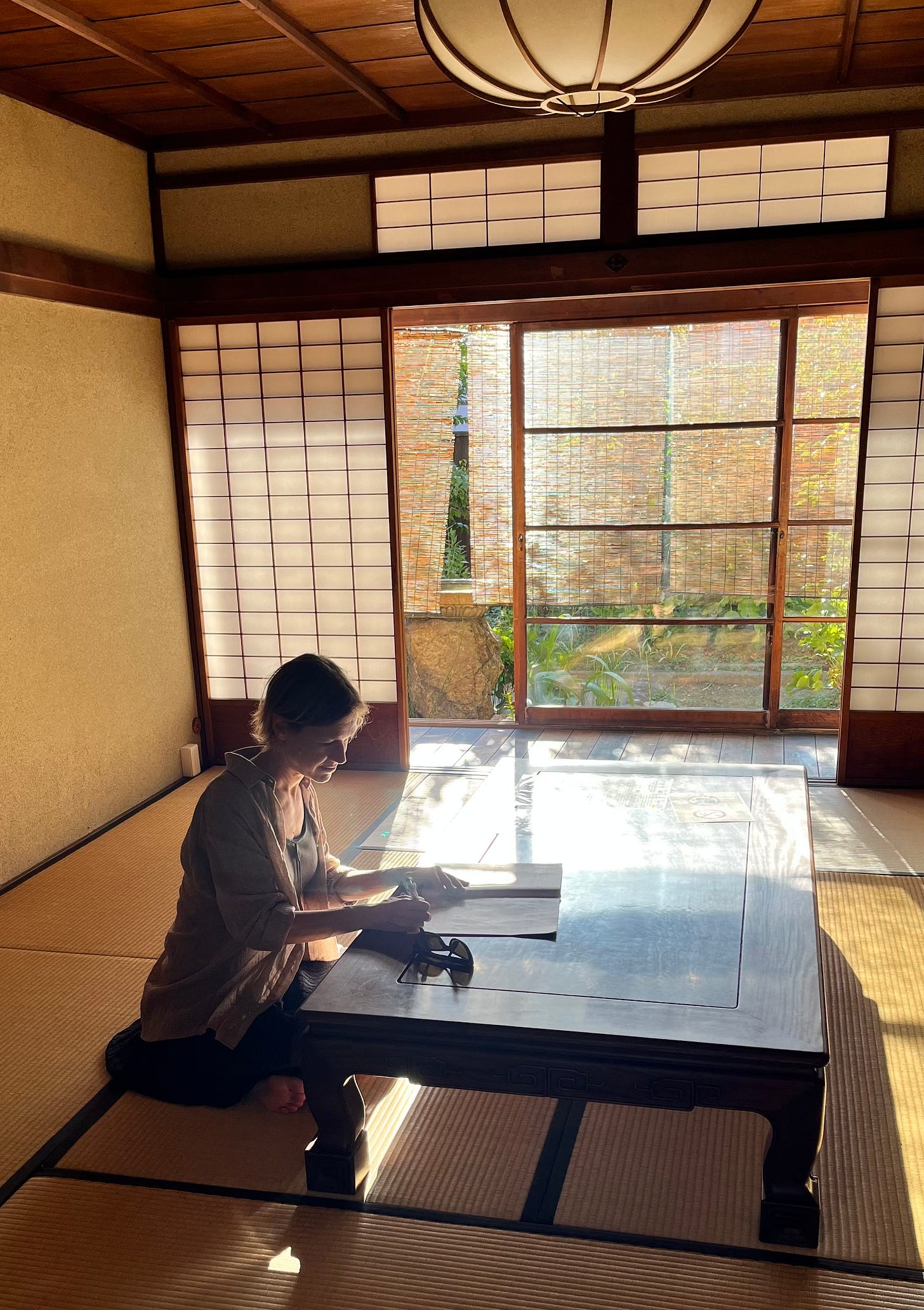🔎 How to Feel at Home in a Foreign Country
With a list of some of my favorite places in Hội An, Vietnam
Hội An means “peaceful meeting place,” but the town in high season is crowded and noisy with cars honking, motors revving, and music pumping from roadside stalls and bars. I move through the heavy traffic on a rusted, malfunctioning bicycle.
“I should hate this,” I yell over my shoulder at Daniel, pedaling behind me—I hate traffic. “But I’m loving it!”
Hội An is my happy place. The town under its canopy of lanterns is crazily perfect and perfectly crazy. I’m excited to rattle along on its pot-holed roads and touched to see entire families—father, toddler, child, and mother holding a baby on her arm—squeezed front to back on one scooter.
As one joke puts it:
What do you call a Vietnamese minivan?
A motorbike.Viet Thanh Nguyen in his memoir A Man of Two Faces.
I’m excited and touched because I’m at home here in Hội An. In this traffic I can literally go with the flow and feel protected by its collective magic: We’re all in this together.


How to Feel at Home in a Foreign Country
In my last newsletter, I wrote about why we seek a home away home when we travel.
It seems contradictory that we would search for a place to feel at home when the point of traveling for most is to get away from what we know. But I believe we need a stable ground or a feeling of safety to open ourselves up for change.
This week, I’d like to write about how we can feel at home no matter where we go.
—> Scroll down for some of my favorites places in Hội An.
1. Home as a way of being
Do you miss not having a home? people often ask me. My answer depends on how I feel at that moment and who I’m talking to, but it’s often an ambiguous response: yes and no. I don’t truly miss having a home because in the five years since I’ve been a nomad, I’ve found a home almost everywhere I went.
When I travel, I want to leave my comfort zone. I long to roam in places I don’t fully understand and where I feel lost from time to time. I go farther and further, my physical journey a means to bring about some inner change. But everything in moderation: As a full-time traveller, I also yearn for places where I can let my guard down, unwind, and be myself.
Home for me is a feeling and not a place, a way of being.
2. Love
Human connections can give us an immediate sense of safety and belonging. When I return to Hội An, I return to a group of friends and acquaintances, people who know my history and whose opinions I value. People who invite me over for coffee and whose hospitality is an opportunity to strengthen our bond. People who ask me what I’ve been reading and what my recent adventures in Sri Lanka have taught me. And people I run into by accident, who wave at me from across the street, who smile in recognition. I’m also very lucky to be nomadic with my husband, a constant presence in my life. After a hectic day of traveling, I feel held in his gaze and trust that I’m understood.
If we travel with friends or pick a destination where others are happy to see us arrive, we can find a home in love.


3. Independence
We can easier feel at home when we’re in a place we can navigate without help. However wonderful it is to have people around to answer my questions, I don’t truly feel at ease unless I can rely on myself to meet my basic needs. In a home away from home, I have direct access to drinking water, pharmacies, fresh food markets, and transportation. I have an Internet connection that enables me to use digital maps and translation apps. I have a rudimentary understanding of how the community functions and what I can expect. I know what roads have dangerous potholes and what restaurants serve my favorite foods. Even doing my own laundry can help me settle in; it’s why I favor homestays and villas over hotels.
Home requires a level of independence. Life feels less foreign when we can manage the most important matters by ourselves.
4. Possessions
We can derive comfort from what we bring with us on the road. I live out of a backpack and am a minimalist by default. Still, I’m attached to the things I carry with me from place to place. Each thing is practical and/or pleasing and connects me to where I’ve been and with whom. When I arrive in a new bedroom, I lay out my essentials for the night: eye-glass case from Paris, earplugs, noise-cancelling headphones, eye mask, my late mother’s muslin scarf (for when I get hot under the heavy sheets), an American T-shirt (for when I get cold under the thin blanket), phone plug, mouth guard, migraine pill (just in case), Dutch water bottle. No matter where I sleep, this collection is a reassuring constant.
Sometimes a few well-chosen belongings, can help us feel like we belong.
5. Habits
Yoga is a daily habit that gives me a sense of home. I practice on uneven wooden floorboards, bare cement, sun-flooded terraces, stained borrowed mats, shell-riddled beaches, plush mattresses, and cold kitchen floors. Wherever I am, I can connect to my core and stretch. I also quickly develop habits specific to each place: This is the lady from whom I buy my greens; there is the place where I park my bicycle; this is my favorite breakfast bowl; and that is the way I’ll dress in this town.
What we do on a regular basis can ground us in unfamiliar environments.
6. Flexibility
The opposite is also true. Sometimes we need to let go of our habits to start feeling at ease. If we’re too hung upon on how things are “supposed to go” we’re bound to get frustrated. The sooner I surrender my expectations and accept reality for what it is, the sooner I feel at home. Breakfast doesn’t have to contain eggs or fruit; it can also be seafood noodle soup or sticky rice. A bed can be a futon or a hammock. Windows can have plastic instead of glass. I can sleep during the day and work at night. I can edit my novel on my phone. I can cut away the part of the papaya where the monkey took a bite and feast on the rest.
It’s easier to change our ways than to change the world we encounter. Being flexible helps us fit in.
7. Affinity
Whenever I feel lost and want to connect to the world, I seek out the the familiar in the strange. This can be the taste of a cherished food (such as marzipan) or standing in front of a body of water. The landscape may be different, but water always connects me to the lowlands of my youth, my father’s sailboat, my mother’s house behind the dike, my childhood skating on frozen ditches, long walks along the Seine River, and warm summers on Greek islands.
No matter how foreign a place may seem, we can always find something that reminds us of home.
8. Writing
When looking for accommodations, I always pay attention to chairs and tables. Can I work there? Can I find refuge in words? Traveling has become a source of my writing. Feeling out of place inspires me to create. But writing is also a homecoming: Only through my writing do I become conscious of my experiences, and this awareness of how I’ve changed is part of the change I want to realize.
A place with a desk gives us comfort, because writing is a kind of home.
9. Self-Care
We feel most at home in the world when we have a healthy relationship with ourselves. When we find comfort in who we are, and not in who we strive to be. When we have confidence in how we deal with whatever comes our way. The quickest way for me to feel better about an unpleasant, unexpected situation is to close my eyes and breathe deeply, go to a place in my mind where I find trust and gratitude. Self-care for me relies on mindfulness.
If we manage to feel at home with ourselves, we can take this feeling with us wherever we go.
Some of my favorite places in Hội An, Vietnam
Baby Mustard, for the best mackerel baked in banana leaf and generous portions of organic vegetables grown in the gardens surrounding this Tra Que restaurant.
Com Linh, for authentic Vietnamese cuisine in the historic old town.
Good Eats, for Western-style health foods such as salads and gluten-free bread, and a great environment to read, write, and work.
Mùa for fine dining with traditional Vietnamese flavors, such as braised duck or purple clams with smoked trout rice.
Thành Nam Quán, for their Hà Nội style noodle soups.
Soul Kitchen, for live music and drinks on bamboo lounge chairs with a view of the ocean.
Xhanh Xhanh, for all your organic shopping and specialty products such as cassava noodles, tofu sausage, and Daklak raw cacao nibs.
Refillables, for their excellent soaps, teas, spices, and beans, their charity shop, and their waste-reducing philosophy.
Pete’s Luxury Wholefoods, aka the granola king, for their high-quality chia seeds and walnuts and more.
Fefe Roastery, for the best Vietnamese coffee, to consume there or freshly ground to take home.
Swing Love, for tailor-made, slow-fashion, vintage looking leather shoes—on appointment only.
Li Me, for tailor-made linen clothes with deep, practical, pockets. (Yes, also skirts and dresses with pockets!)
All the local markets (one, two, three, four—there are more) for everything you might want, the best wild greens, seasonal fruits you’ve never tasted before, Da Lat avocados, taro root, cao lầu noodles, duck eggs— a list that can go on and on. Also for meeting the market ladies who will greet you with a smile or with a proud challenge in their eyes, ready to do business and crack a joke.


Related Posts
Time to Say Goodbye
That’s it for today. Stay tuned for more on Vietnam and my reading recommendations in the coming weeks. I’ll be here until mid-May—hurray!
All my best,
Claire
P.S. What if I don’t have a P.S one day?










Thanks much for this read. I'll be going there tomorrow, staying awhile and will try all things on your list! Linen with pockets - can't wait ♥️.
Really enjoy this one Clare! I circled back to it as I’ll be traveling to HoiAn for the last weeks of October. ❣️ if you were only there for one week, do you recommend staying in the Old Town or on the beach?